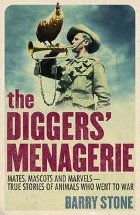The Diggers' menagerie: mates, mascots and marvels - true stories of animals who went to war by Barry Stone

ABC Books, 2012. ISBN 0 7333 3009 4.
(Ages 10+) Recommended. Animals. War. Non fiction. I seem to have
read a number of books with a similar theme over the past few years,
starting with Anthony Hill's wonderful, Animal heroes (2005)
which outlined true stories of animals that had made a difference,
then the story of Sarbi, the bomb detection dog which went missing
believed dead in Afghanistan in 2008 (Saving Private Sarbi)
as well as the range of books about Simpson and his donkey by
authors such as Jackie French, Mary Small and Mark Greenwood amongst
others, while a range of fiction books have appeared, giving details
of the animal in a fictional framework. Examples include The
horses didn't come home by Pamela Rushby, a tale of the Walers
that went to WW1, never to return, or David Hill's The red poppy
or Michael Morpurgo's War horse, and Farm boy.
The Digger's menagerie is an excellent non fiction compendium
giving an overview of the wars that Australia has been involved in,
alongside stories about the animals that went with the soldiers,
playing a vital role as a mascot, or a beast of burden, a mate,
explosive detector and communication expert. From stories of pigeons
taking messages between trenches, to the horses in the Boer War
succumbing to the noxious weeds, or the Walers left in Palestine and
Egypt at the end of WW1, to the dogs that have saved lives finding
hidden bombs, to the dog, Horrie, an Egyptian stray smuggled back to
Australia, all are fascinating, and with the setting, gives a
different perspective to Australia's involvement in war.
Little gems of information are given along the way (Conan Doyle,
Kipling and Churchill were all journalists during the Boer War),
statistics that are mind boggling (horses with the Boers carried 200
pounds of baggage, whereas the British horses were made to carry 300
pounds!), stories about people such as war artist, Septimus Power
(there are many of his war paintings at the Australian War
Memorial), or Simpson and his donkey and Stan the tobacco chewing
ram. Some stories are a little long, an index would have helped
students to access some of the stories, but the ones listed in the
contents page make those accessible.
This is a good addition to the library where students will be able
to research the many stories when studying the impact of animals at
war or simply looking at Australia's participation in war using a
fresh approach.
Fran Knight